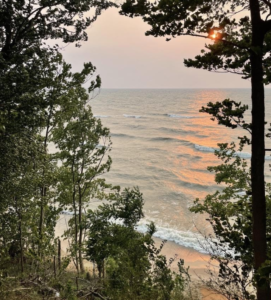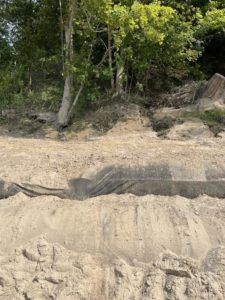Maintaining Communities Built on Sand
– by Linda McIntyre
Hello and thanks for reading! I’m really excited to be one of The Maintainers’ 2021 Summer Research Fellows. I’m looking at the tradeoffs between maintenance and ecological stewardship. I’m still refining my approach but I know that one area of focus will be coastal ecology.
I became interested in this issue when I was a writer and editor at Landscape Architecture magazine, mostly in the context of barrier islands on the Atlantic coast, and undertook a policy-focused case study of Fire Island when I was a mid-career planning student at New York City’s Hunter College in 2013.
But recently I’ve been able to get a close-up glimpse of a different kind of coast: last year, during the pandemic, I moved from the East Coast to my home state of Michigan for family reasons. While I grew up outside Detroit, I’ve been on the west side of the state, down the street from my sister, in a place I had visited many times but never for more than a week. This is a small town perched on a bluff on the Lake Michigan shore, where we have access to two public beaches and several hiking trails that wind around and over tall dunes.

During my time here, I have both served as a planning commissioner and been a curious citizen watching local governments, and property owners, struggle to manage these sandy shorelines and land areas. This task has been difficult recently, owing in part to fluctuating water levels, including a record high in 2020 that destroyed the stairs that take visitors down a bluff to one of the public beaches.

Find image here on the Southeastern Wisconsin Coastal Resilience website
These high levels came only a few years after a record low in January 2013. The high water, along with strong storms, which are regular occurrences here, has also contributed to the erosion of dunes, both along the shoreline and inland.

Maintenance here has generally taken the form of repairing and rebuilding beach and other recreational infrastructure. The Douglas beach stairs were rebuilt to a more resilient standard (at city expense) and the beach reopened this summer, with stabilization measures such as large tubular sandbags and netting.

But erosion is still a problem, and not just on public property. Walking along the shore from one of the area’s public beaches to the other, I have been struck by the damage done to private houses, some of which have stood for many decades…

…and by the fact that people are still building new ones right on the dunes. These usually feature “hard” shoreline protection of some kind–metal seawalls, stone or concrete riprap. Some owners of older houses are installing similar measures, or using more affordable “soft” measures such as sandbags.
Many houses here, especially on the shoreline, are second homes or vacation rentals. The local economy is dependent on these seasonal residents and visitors. And they come here for the sandy lakeshore and picturesque dunes.

So it’s understandable that people want to protect their property, and that tourism-dependent towns spend public funds rebuilding their damaged attractions. As the nonpartisan, nonprofit journal Bridge Michigan has reported, western Michigan homeowners have been seeking permits for this kind of work in record numbers. But these measures merely displace wave energy to nearby sites and interfere with the natural movement of sand, often triggering acrimonious disputes among neighbors. And according to experts such as Guy Meadows, director of the Great Lakes Research Center at Michigan Technological University, they’re ultimately doomed to failure, sometimes permanently damaging natural sand flows.
The situation has many of the characteristics of a wicked problem. Ecology in altered landscapes is difficult to manage, even when private property rights aren’t implicated. For example, a group of well-meaning volunteers tried to improve the ecology of Mount Baldhead, a dune park and trail near Oval Beach, by removing invasive species. But the action accelerated erosion on the dune. The city is in the process of replanting some of the affected areas, a task greatly complicated by the abundance of deer in the area, which feast on newly planted trees and shrubs (even those alleged to be “deer resistant”).

What, exactly, is “the environment” here? Historically, the coastal dunes shifted while the inland dunes were colonized with vegetation, and the area generally inland was dominated by heavy forest cover. But in the 19th century, the local lumber trade clear-cut the area and an entire town at the mouth of the Kalamazoo River, where it meets Lake Michigan, was engulfed by sand. Economic focus shifted to agriculture, and, starting in the late 1800s, tourism, and those industries shape the way people today think about and manage the land.
This is, to my mind, an ideal context in which to consider my research question. What, exactly, should be maintained here? The beaches that help sustain the local economy? The private property that provides, via taxes, more than 60 percent of local revenue? Or the dunes themselves and their associated ecosystems, which are what bring so many people here to visit and live? Who should decide? And who should pay?
I’ll be looking at what other coastal communities are doing, and what researchers are finding out about evolving impacts and the measures taken to address them. I hope to look at land management in other contexts, such as parks, as well. There are no answers yet, but the questions become more urgent every day.
NOTE: All images that are not explicitly cited from an external source were created by the author.